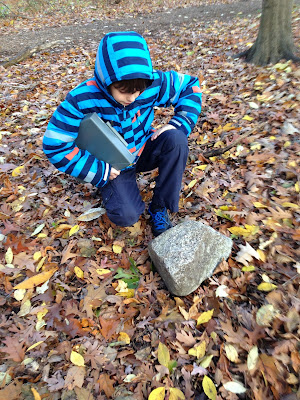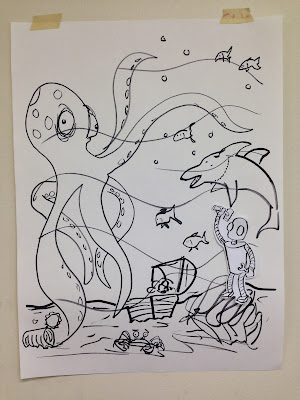Tuesday, November 26, 2013
Friday, November 22, 2013
Dr. George and IGNITE Ann Arbor

Dr. George came by our class this afternoon and shared his five-minute presentation on the Guatemalan windmill project that he recently delivered at Ignite Ann Arbor.
Ignite is a really cool event with a simple idea: Speakers are allowed five minutes of stage time, and twenty slides. There are no pauses, breaks, questions, or do-overs, and the slides advance automatically. Once the slideshow begins, you've got five minutes to give your presentation.
Dr. George's topic was the windmill project that kids have been working on. Check out George's blog for photos of students hard at work in Science Club, stripping old microwaves for parts to construct generators.
George also brought a version of the generator for the kids to try out:
 |
| Lee gives the generator a crank. Despite quite a lot of spinning on his part, it doesn't do much with a halogen bulb (visible on the wooden platform right by Lee's knee.) |
 |
| An LED, on the other hand, provides a much more powerful punch, and with less work. |
The Music Cafe
Our first Music Cafe was last night, and it was remarkable. Kids performed solo, in duos, and in small ensembles. Many played different instruments for different pieces, exploring and expanding their musical horizons.
The kids all chose what songs they would perform, leading to a wonderful hodge-podge of different styles and genres. It was all orchestrated by our Music teacher Josh, whose boundless, good natured enthusiasm and positivity inspires kids to take risks that would probably shake the average person to their core. It was a delightful evening, full of talent and goodwill. (Videos will hopefully be coming soon!)
Monday, November 18, 2013
Morning warm-up: set a fairy tale in the modern day
Today's warm-up is a writing prompt: "Pick a classic fairy tale, and set it in your modern-day hometown."
Lee shared a portion of his, in which one of the Three Little Pigs opts to live in a motel, rather than renting an apartment or buying a condo or a house. This led to an impromptu math exercise, during which we calculated how much he was spending at the motel, versus renting (or buying) a place. We decided that the pig was basically throwing his money away. Economics!
Lee shared a portion of his, in which one of the Three Little Pigs opts to live in a motel, rather than renting an apartment or buying a condo or a house. This led to an impromptu math exercise, during which we calculated how much he was spending at the motel, versus renting (or buying) a place. We decided that the pig was basically throwing his money away. Economics!
Wednesday, November 13, 2013
Block printing workshop with Gregg Perez
Guest Artist Gregg Perez was back today to help us create our own block prints today. Each student selected a drawing of their own (mostly line drawings of things we've studied at County Farm Park), then set to the task of carving their block. The results were impressive...
Not everyone was able to finish their block today, but we'll be spending more time with this project next week.
Many thanks to Gregg for his time and expertise! Please check out his work here and here! It's really lovely stuff.
Not everyone was able to finish their block today, but we'll be spending more time with this project next week.
Many thanks to Gregg for his time and expertise! Please check out his work here and here! It's really lovely stuff.
The Blue Fugates, Mendel, and Punnett squares
As part of our study of Identity, we've been learning about traits, inheritance, and genes. Today, we learned about the strange case of the "Blue Fugats" of Kentucky, Gregor Mendel and his studies of pea plants, and how to create and read Punnett squares.
We kicked things off today with a reading about the mysterious blue people of the hills of Kentucky: The Blue People of Troublesome Creek
This led to the introduction of Gregor Mendel, adorably (and quickly) summarized in this video:
We concluded with a crash course in Punnett squares, discussing dominant and recessive traits, homozygous and heterozygous alleles, and phenotypes and genotypes.
It was a heady day. Ask your child about the blue people of Kentucky, or try out some Punnett squares together and piece together some family history!
We kicked things off today with a reading about the mysterious blue people of the hills of Kentucky: The Blue People of Troublesome Creek
This led to the introduction of Gregor Mendel, adorably (and quickly) summarized in this video:
We concluded with a crash course in Punnett squares, discussing dominant and recessive traits, homozygous and heterozygous alleles, and phenotypes and genotypes.
It was a heady day. Ask your child about the blue people of Kentucky, or try out some Punnett squares together and piece together some family history!
Tuesday, November 12, 2013
Guest Artist: Gregg Perez
Math group: bar graphs
It's a whole-middle school lesson in Math today, focused on creating useful graphs to present data. (Ask the kids about the clowns...)
Monday, November 11, 2013
Friday County Farm Project time
Last Friday, we spent most of the afternoon in County Farm Park collecting data for our projects. Jules, one of our advisors from the University of Michigan joined us to help out.
 |
| In the field, exploring Fox Prairie. |
 |
| Jules, talking with Emma and Margaret. |
 |
| Grayson, examining a stone in Britton Woods. What can this rock tell us about glacial activity in Southeast Michigan? |
 |
| Lee, pictured with what might be evidence of deer chewing on bark. Matthew and I saw a large buck strolling through the woods about twenty minutes later. |
 |
| The deer are elusive and difficult to photograph, but these guys are plentiful, scurrying about and preparing for Winter. |
 |
| Keira, documenting the edible -and poisonous- berries of County Farm Park. Kaeli continues her tree census behind her. |
We'll continue to visit the park to gather data for our projects in the weeks ahead, and some students will be collecting data throughout the school year as sustained projects.
Writer's Workshop: Thinking about setting
In Writer's Workshop today, we focused on setting, and how it can influence a story.
We started out with some characters in need of settings.
We brainstormed some scenes where these characters might reasonably be found.
Our cowboy was placed in a saloon, our mermaid on the ocean floor, and our robot was stationed on Mars.
 |
| Details suggested for our mermaid's world: An octopus, a dolphin (with two fins, as I got the placement of the first one wrong), a crab, some fish, an old can, and a treasure chest. |
 |
| Our robot was placed on the surface of Mars, complete with dormant volcanos, a gleaming rocket ship, a broken time machine, and a hovering alien. |
After we created rich environments for these characters, the kids spent some time coming up with stories inspired by their settings.
After sharing our ideas, I threw a curveball: We shuffled each character from the setting that we created for them, and placed them into an unexpected scenario:
 |
| Our cowboy suddenly finds himself on the surface of Mars. |
 |
| Our robot wanders a busy sea floor. |
 |
| A Snowy Egret wanders into a chaotic saloon. |
 |
| Our mermaid finds a way to beat a traffic jam. |
Inspired by these improbable scenarios, students were tasked with coming up with stories that made some kind of internal sense. After some writing time, I asked for volunteers to read what they had come up with:
 |
| (This is one of my favorite sights as a teacher.) |
Everyone is working on a draft of a story that features at least one of our settings, and at least one of our characters. They are, as you might imagine, wildly imaginative.
Subscribe to:
Comments (Atom)









































